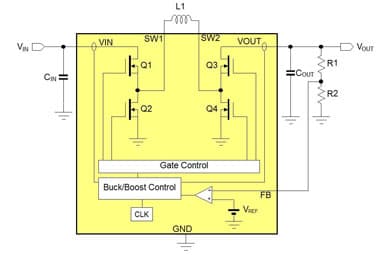Selecting a Step-up/down (Buck-boost) Converter
Step-up/down (Buck-boost) Converters
A Buck-boost converter is used in applications where input voltage can vary, either below or above the output voltage (i.e. when using batteries).
The four internal MOSFET switches will be automatically configured to form a Buck when VIN exceeds VOUT and change to Boost operation when VIN falls below VOUT. This makes Buck-boost ideal for battery-powered applications to extend battery life when the battery voltage falls below the regulated output voltage value.
Due to the fully synchronous operation, the efficiency of the Buck-boost converter is very good. The output current capability in Buck mode is normally higher than in Boost mode, due to step-up requiring higher switch current at the same load conditions when compared to Buck mode.
The MOSFET voltage ratings will determine the maximum input and output voltage range.
In applications where the output voltage does not need to be referenced to ground (like LED drivers), buck-boost converters with a single switch and rectifier are used. In most cases, the output voltage is then referenced to VIN.
You might be interested in...
- Feature Product
- Parametric Search: Get your design started in no time!
